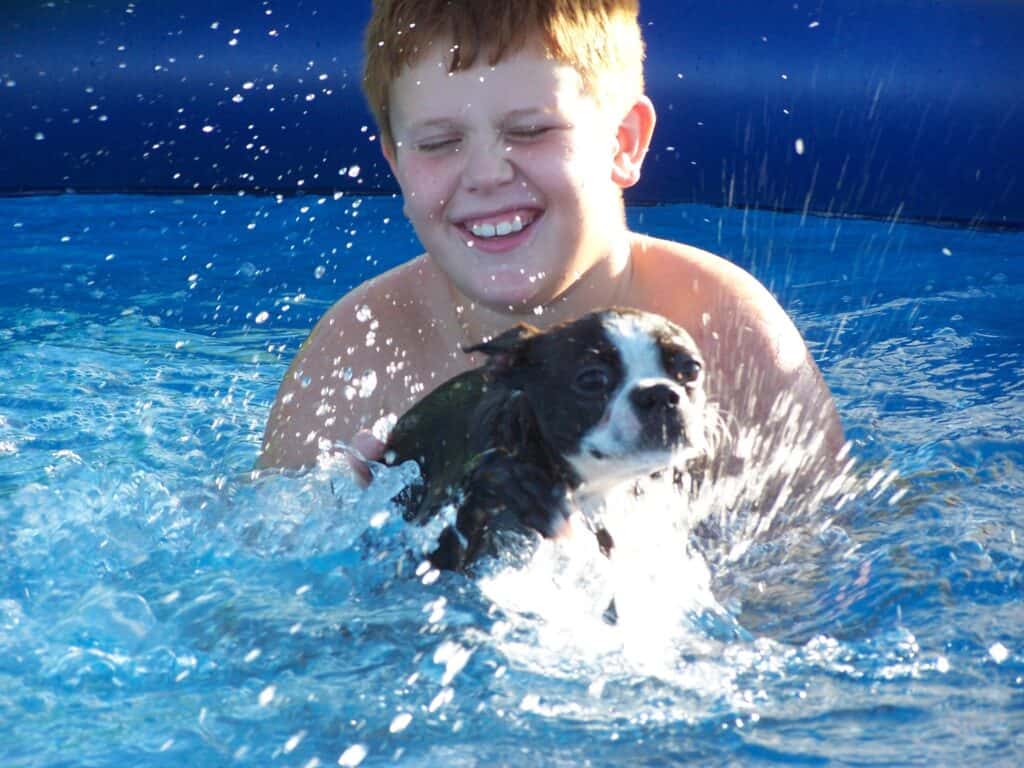Most dogs like to swim and seem to love being in the water. However, can Boston Terriers swim? To determine that, I’m going to see whether Boston Terriers like water, how to introduce them to swimming, and what you can do to train your pet in swimming safely.
Quick Navigation
Are Boston Terriers Good Swimmers?
Yes, Boston Terriers are good, natural swimmers like many other dog breeds. While they are not the worst swimmers, they can be good swimmers as long as they are healthy and appropriately trained. Some health conditions, behaviors, and training may influence whether a Boston Terrier can become a good swimmer or not.
Let’s see how your Boston Terrier can feel accustomed to water activities.

Factors That Affect a Boston Terrier’s Ability to Swim
Boston Terriers can be great swimmers depending on their health, training, and behavior. However, it’s not ideal to leave them swimming for a long time or great distances. So, can Boston Terriers swim?
On average, Boston Terriers swim about the length of a swimming pool and back. Although Boston Terriers can swim, there are certain physical and behavioral factors that may limit the time and distance they swim.
- Brachycephalic breed: There’s a misconception that Boston Terriers may not swim due to them being a brachycephalic breed. They naturally have heavier heads and shorter snouts, making them exert more energy in breathing and tire out easily.
- Paws: Boston Terriers don’t have canine webbed feet or the skin between the toes.They only have about 1/2 to 3/4 of skin between the toes that covers the entire opening. Unlike non webbed feet dogs, dogs with webbed feet such as Labradors, Weimaraner, and Newfoundland swim longer and stronger. However, pugs, pekingese, and French Bulldogs are bad swimmers.
- Temperament: Boston Terriers are among the most strong-willed breeds, causing them to become bold and adventurous. However, this also means they can be a bit of a handful, especially when sharing swimming space or playing with other dogs.
- Underlying health conditions: Apart from brachycephalic syndrome, it might be suffering from other underlying medical conditions such as arthritis. Usually, these conditions tend to deteriorate when the joints are exposed to cold. If it’s diagnosed with respiratory or joint problems, it’s not advisable to let it swim
Do Boston Terriers Like Water?
So, can Boston Terriers swim? Boston terriers do not love water. However unlike Shih Tzu or Daschund that are bad swimmers, Boston Terriers can become natural swimmers, particularly if you introduce them to it at an early age.
They tend to feel afraid of the lake water when they feel forced about being in it. Hence, it’s important that you let them try it at their own pace, and make sure to constantly use positive reinforcement.
However, considering that not all Bostons love water, you can try whether yours do by sprinkling water on it using a garden hose or taking it in a foldable pool. If the Boston terrier comes nearer when sprinkling water on it he surely does love water, even large masses such as the lake.
Introducing your Boston terrier to Water and Swimming
For most dogs, 1 minute of swimming equates to 4 minutes of running. With the feet continually padding, you can use this as a form of training and exercise.

Most dogs are natural swimmers, and Boston Terriers can become great swimmers as long as you train them for it. So, can Boston Terriers swim? These are the steps you can take to help your Boston Terrier swim for longer distances and feel comfortable in the lake water.
Wait for the Right Time
Although many people recommend training these dog breeds how to swim from a young age, it doesn’t mean you get a several weeks old Boston into water. Even if you might be there to help prevent drowning, getting a Boston terrier into the water at this young age might expose it to health risks such as hypothermia.
Instead, wait until your Boston Terrier is around 4 to 6 months old. Like with other dogs, at this age your Boston Terrier should have stronger bones and muscles to help them withstand water pressure, temperature changes and become great swimmers.
Swim in Smaller Pools
It is not advisable to teach your Boston terrier to swim in big pools or the lake. However, you can teach your young Boston Terrier to swim by filling your bathtub with water and setting it to the room temperature. Usually, this will introduce Boston to being wet without exposing it to a sudden temperature change.
Walk in Puddles of Water
Even a mature Boston Terrier can be frightened and confused when put into a pool of water all of a sudden. To prevent this and make your Boston Terrier acquainted with the sensation of being wet, walk your Boston along puddles of water, beside the lake, or on the beachfront.
Take your time until your Boston Terrier feels ready to swim. Usually, the dog will follow in the water, move out of the water when it feels uncomfortable and come back in when it feels ready. Over time, the dog might start entering into deep water and learning to swim by itself.
Start Gently
Dogs can become great swimmers, if you gently place them in the water starting with the feet first, and keep doing it until your dog paddle. Be sure to support your dog’s weight until it paddles. You can give treats or a toy as a form of encouragement and reward.
Go Bigger
Dogs can become great swimmers if you carefully guide it to a bigger swimming pool such as a lake or beach and guide it off the edge. Support its weight even if you’re using a life vest. Try to swim back and forth until your dog finds the courage to do it alone.
Use Swimming as a Socialization Activity
Similar to training and other activities, your Boston Terrier will learn how to survive in water through frequent swimming. If you like to swim, swim with your pet on different water surfaces such as a pool, lake, or beach. Dogs can also become best swimmers if they play fetch in the shallow parts of the water with their owner.
Don’t Force Your Pet
When teaching your Boston to swim let your Boston Terrier explore the water freely. Most Boston Terriers can be sensitive, so avoid using harsh or hostile tones. Since this breed doesn’t like to swim, forcing it to swim can only make it one of the worst swimmers and make the activity a traumatizing experience.
Supervise
Always make sure you are with your Boston while they swim, just as you would do with your children. Boston Terriers are not naturally great swimmers, so they are still prone to drowning.
Rest and Recover
One of the mistakes you can make after your Boston Terrier learns how to swim is to let it swim for longer periods at great distances, depriving its energy. Even with great swimmers, this exposes the dog to the danger of being exhausted and unable to swim back out.
You can tell that your Boston Terrier is exhausted if it starts breathing heavily. Frequent exhaustion might also make Boston Terriers lose interest, and they will no longer enjoy it. The best way to prevent this is to let the dog swim for around 15 minutes and then rest and recover.
Boston Terrier Swimming Safety Measures and Tools
About 25% of dogs suffer from hyponatremia, which happens when a dog consumes too much water, including when swimming. So, can Boston Terriers swim? For your peace of mind, these are the things you can do to make Boston terrier swimming a fun and memorable activity.

Drinking Water
Although the dog might not feel as hot when in the water, the low water temperature compromises the dog’s ability to control its body temperature. Also, swimming is an intense exercise that requires energy. That means the body burns more calories, and the heart rate might increase.
Even if Boston Terriers are swimming in a clean-water pool, the increased breathing rate means they can’t drink water without drowning. Keeping in mind that the dog’s skin can’t absorb water through the skin like a sponge, there are higher chances of dehydration.
This might cause sluggishness and dizziness, which might make it drown. It’s therefore advisable to give Boston Terriers high-calorie foods and clean-drinking water before taking them to the pool. Typically, this will ensure Boston Terriers are hydrated and energetic to paddle.
Flotation Devices
Keeping in mind that Boston Terriers are flat-faced dogs with heavy heads, there are chances of the dog’s nose being submerged in the water even if the rest of the dog’s body is still above water. Typically, this can cause breathing distress and possible drowning.
Flotation devices for dogs are vests or life jackets that are constructed using buoyant materials. Usually, these materials trap air, helping the body of the dog to displace water equal to its weight, preventing it from sinking.
Although most people use a life jacket when introducing the dog to swimming, a Boston Terrier is a brachycephalic breed, and even the best swimmers can tire out and drown. It’s therefore advisable to put on floating devices on your Boston Terriers regardless of their swimming experience.
Toys
Even if Boston Terriers are brave dogs, they don’t like water, and they might fear getting into a lake. Instead of forcing the dog, you can use a positive reinforcement method to motivate the dog to jump into the lake water, such as placing its favorite toy in the lake water.
Remember not to use a sinking toy, as Boston might be tempted to dive and fetch it, increasing the risks of drowning. Instead, use floating toys that will move with the water waves of the lake, challenging the dog to follow and fetch.
It’s also advisable to go for medium-sized and lightweight toys so the dog won’t accidentally swallow when trying to fetch or use too much energy trying to swim with the toy between its teeth. You can then give the dog a treat after it successfully fetches the toy.
Related Questions
What Are the Best Activities for Boston Terriers?
Although a Boston Terrier is a brachycephalic breed, it can engage in low to medium-intensity activities like walking, scent games, and mental stimulation games. Active Boston terriers like high-intensity exercises that involve the feet such as chasing, fetch games, and agility training.
Are Boston Terriers Easy to Train?
Yes, Boston Terriers are easy to train thanks to their clever, determined, and obedient nature. While they can be stubborn at times, reward-based training works best for them to remember rules, commands, and tricks. In effect, you can housetrain a Boston Terrier to become an ideal pet for your family.
Conclusion
So, can Boston Terriers swim? Boston breeds are fairly good swimmers as long as they are fit and trained for the activity. As natural swimmers, dogs have the instinct on how to react in the water. However, it would be better to supervise them, remember safety measures, and flotation devices.
